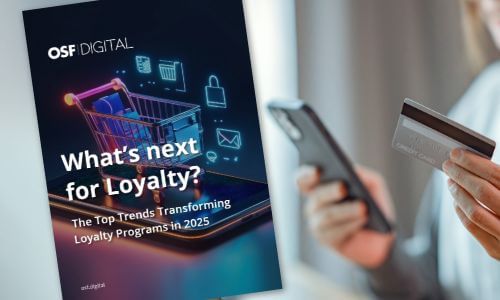With customer loyalty more than just repeat purchases, businesses are rethinking how they engage and retain customers. The financial impact of loyalty programs has never been more evident, with the loyalty management market projected to grow from $10.86 billion in 2023 to $23.69 billion by 2028 at a CAGR of 16.88%1. With nine out of ten consumers2 enrolled in at least one loyalty program and 90% of companies offering loyalty initiatives3, brands must go beyond transactional benefits to create meaningful, long-term customer relationships.
The Financial Impact of Loyalty Programs
Loyalty programs are powerful revenue generators. Members of loyalty programs contribute 12-18% more annual revenue growth4 than non-members, and loyal customers spend 43% more on average. Furthermore, 83% of businesses with loyalty programs5 report positive ROI, with loyalty initiatives delivering 5.2 times more revenue than their costs.
Brands face challenges in differentiating their loyalty offerings in a competitive market. Standing out requires leveraging cutting-edge trends that align with evolving customer expectations. Below, we explore key trends shaping the future of loyalty programs in 2025.
The Evolving Mechanics of Loyalty
To thrive in today’s market, brands must move beyond traditional points-based programs and embrace innovation. Here are some of the biggest trends transforming loyalty programs:
1. Hyper-Personalization Using AI
AI-driven personalization is revolutionizing loyalty programs by delivering customized experiences based on real-time data. By analyzing customer behaviors, preferences, and past interactions, AI enables brands to craft offers that resonate with individuals. For example, an airline loyalty program might proactively offer an exclusive upgrade to frequent flyers based on their travel history. The evolution of AI has seen three significant waves: the first wave focused on predictive capabilities, the second introduced co-pilots to assist human decision-making, and now, the third wave brings autonomous agents. These agents enhance personalization by independently managing customer interactions and delivering tailored experiences across various platforms.
2. Gamification in Loyalty Programs
Gamification is an increasingly popular way to boost customer engagement. By integrating game-like mechanics such as challenges, leaderboards, and rewards, brands can make loyalty programs more interactive and fun. Retailers, for instance, are launching augmented reality (AR) experiences where customers earn rewards by engaging with digital scavenger hunts or unlocking exclusive discounts through in-app games.
3. Omnichannel Loyalty Programs
Today’s customers interact with brands across multiple touchpoints6—from mobile apps to physical stores and e-commerce platforms. Omnichannel loyalty programs create seamless experiences by allowing customers to earn and redeem rewards across all channels. A customer might purchase online, receive personalized offers via SMS, and redeem rewards in-store, all within a single loyalty ecosystem. Ensuring consistency across these channels is critical for maintaining customer engagement.
4. Subscription-Based Loyalty Programs
Subscription-based loyalty models are gaining traction as customers seek exclusivity and premium benefits. Amazon Prime and Sephora’s Beauty Insider are prime examples of programs that offer unique perks, early access to products, and special discounts in exchange for a monthly or annual fee. These programs provide a steady revenue stream for businesses while fostering a deeper sense of belonging among customers.
5. Tiered Loyalty Programs
Tiered loyalty programs create aspirational value by incentivizing higher spending and engagement. Customers move up through different tiers—each offering more exclusive benefits than the last—encouraging them to increase their spending to unlock better rewards. For example, airline frequent flyer programs provide escalating perks such as lounge access, priority boarding, and free upgrades as customers progress through different membership levels.
Looking Ahead: The Future of Loyalty in 2025 and Beyond
Loyalty programs are no longer just about discounts and rewards—they have become strategic assets that drive customer lifetime value. As brands refine their loyalty strategies, integrating AI-driven personalization, gamification, omnichannel engagement, and premium loyalty experiences will be crucial for staying ahead. The key to success lies in delivering value-driven, emotionally engaging, and technologically advanced loyalty experiences that resonate with today’s digitally savvy consumers.
At OSF Digital, we specialize in helping brands transform their loyalty programs into revenue-generating powerhouses. By leveraging AI, automation, and data-driven insights, we enable businesses to create personalized, seamless loyalty experiences that drive customer engagement and long-term business growth. Check out our work with schuh, Harvey Nichols and Marks & Spencer.
Are you ready to redefine your loyalty strategy and program for 2025? Contact us to learn how OSF Digital can help you build next-generation loyalty programs that drive results.
Sources:
- https://www.globenewswire.com/news-release/2023/08/29/2733803/0/en/Loyalty-Management-Market-Size-Share-Analysis-Growth-Trends-Forecasts-2023-2028.html
- https://www.snipp.com/blog/loyalty-program-providers-how-to-choose
- https://queue-it.com/blog/loyalty-program-statistics/
- https://www.businessdasher.com/customer-loyalty-statistics/
- https://antavo.com/blog/global-customer-loyalty-report-2025/
- https://www.youtube.com/watch?v=G-V2y9lHK4c&t=71s





